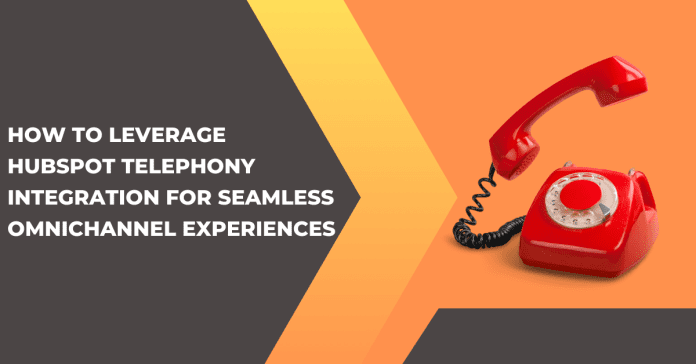Last Updated on March 15, 2024 by Umer Malik
The customer journey today is more complex than ever before. With multiple touchpoints across various channels, delivering a unified and frictionless experience is critical for businesses seeking to drive growth.
This is where seamless omnichannel strategies enabled by tools like HubSpot Telephony Integration can prove transformational. Let me explain in detail.
Table of Contents
The Rise of Connected Strategies
Integrating seamless omnichannel experiences is now a competitive advantage rather than an option.
Siloed channels and disjointed customer journeys can significantly hamper brand perception and loyalty. Instead, businesses need to embrace connected technologies to:
- Create unified perspectives of customer interactions across all touchpoints.
- Gain actionable insights from cross-channel data analytics.
- Drive contextual and continuous conversations through AI-enabled tools.
- Deliver fast and frictionless experiences across channels.
With customers increasingly expecting seamless omnichannel engagements, the companies that succeed are those evolving their strategies to digitally transform experiences.
Transitioning From Episodic to Continuous Customer Interactions
“89% of all companies have already adopted a digital-first business strategy or plan to do so.” This shift from sporadic to continuous customer engagements is being propelled by digitally native companies disrupting traditional models.
Interacting with customers only during transactions is no longer sufficient. Instead, businesses need to foster continuous relationships by:
- Being present at every stage of the customer lifecycle with relevant touchpoints.
- Adding value through expanded offerings, exclusive content, and personalized recommendations.
- Building trust and loyalty through transparency, proactive service, and humanized experiences.
This transition requires reimagining processes, systems, and strategies with the customer at the core.
The goal should be frictionless movement across channels, with context and memory retained at each step. HubSpot phone system integration for call centers can help bridge communication gaps across channels.
Four Pillars of Connected Customer Experiences
“62% of companies view customer experience delivered by a contact center as a competitive advantage.” Four foundational pillars can help craft differentiated connected customer experiences:
1. Response-to-Desire Experience
Meeting customers’ needs and wants readily and effortlessly builds enduring engagement. Strategies include:
Convenience – Access information instantly 24/7 via self-service options.
Personalization – Tailor interactions based on individual preferences and history.
Proactivity – Anticipate needs and address them before customers ask.
2. Curated Offerings
Customizing interactions and recommendations to align with customers’ unique interests fosters loyalty. This entails:
Individualization – Get to know each customer and what matters most to them.
Relevance – Deliver hyper-targeted content and offerings based on preferences.
Exclusivity – Provide VIP treatment through members-only promotions and sneak peeks.
3. Coach Behaviors
Guiding customers toward efficient and optimal decisions earns their trust and appreciation. Ways to achieve this include:
Education – Share tips and advice to help customers help themselves.
Incentives – Encourage desired behaviors through personalized promotions.
Feedback – Provide real-time suggestions during interactions to optimize outcomes.
4. Automatic Execution
Proactively addressing customer needs before they arise enhances experiences. Steps for this include:
Predictive Analytics – Identify potential needs based on data insights.
Triggered Interactions – Initiate contextual conversations when intent is detected.
Preconfigured Preferences – Take automated actions based on pre-set individual parameters.
With these pillars as the foundation, businesses can deliver differentiated connected experiences that deepen engagement.
Implementing Connected Strategies in Business
“55% of startups have adopted a digital business strategy, compared to 38% of traditional companies.” This reveals a pressing need for established companies to reimagine experiences, or risk losing ground.
Key Considerations
Customer-First – Make decisions based on how it impacts customers rather than internal metrics.
Data-Driven – Leverage analytics across interactions to uncover needs and opportunities.
Adopt New Technologies – Continuously evaluate emerging tools that can enhance experiences.
Agile Processes – Take an iterative approach to enable swift adaptation.
Avoiding Misconceptions
Some common pitfalls to avoid with connected strategies include:
- Assuming digital equates to impersonal – find ways to humanize interactions.
- Focusing only on digital channels – Integrate across physical and digital experiences.
- Implementing disjointed solutions – Ensure tools enable unified data and insights.
- Prioritizing cost over customer experience – view connected strategies as an investment.
The key is to start by identifying pressing customer pain points and implementing solutions that directly address those needs.
HubSpot Telephony Integration: A Game-Changer
“Companies with the strongest omnichannel experiences retain 89% of their customers on average, compared to 33% retention for companies with weak omnichannel customer experience.” This stark contrast highlights the game-changing impact HubSpot Telephony Integration can have on customer retention by bridging digital and voice channels.
HubSpot Telephony seamlessly unites interactions from phone calls, live chats, emails, and more within a unified CRM platform. Core benefits include:
Complete Visibility
With all conversations and data integrated into one system, agents have complete context during engagements.
Enhanced Personalization
Unified customer insights enable hyper-personalized, no-repeat conversations across channels.
Improved Management
Managers have holistic visibility into performance metrics and can optimize strategies.
Reduced Customer Effort
Customers don’t have to repeat information or switch channels to find resolutions.
Omnichannel Analytics
Single-dashboard analytics provide unprecedented visibility into omnichannel strategies.
Streamlined Workflows
Pre-built integrations with Service Hub streamline every interaction for agents.
For businesses struggling to connect experiences across channels, HubSpot Telephony Integration can fast-track omnichannel success.
Best Practices for Leveraging HubSpot Telephony Integration
To maximize the impact of HubSpot Telephony in enhancing omnichannel customer experiences, here are proven best practices:
- Setup
- Perform pre-implementation audits of existing tools and workflows.
- Map customer journeys to identify gaps and pain points.
- Outline required configurations, integrations, and migrations.
- Optimization
- Provide comprehensive agent training on new functionalities.
- Monitor performance daily and tweak strategies based on insights.
- Proactively identify issues and continuously refine workflows.
- Enhanced Interactions
- Trigger contextual conversations when customers switch channels.
- Resolve common issues faster with AI-recommended knowledge base articles.
- Automatically log all interactions for future reference.
- Improved Data Practices
- Track omnichannel metrics like channel switching and resolution rates.
- Uncover channel preferences based on past interactions.
- Capture voice-call sentiments for richer insights.
With an iterative optimization approach, the capabilities of HubSpot Telephony can be fully leveraged for superior omnichannel experiences.
Challenges and Solutions with HubSpot Telephony Integration
Transitioning to new systems can be daunting. Here are common challenges businesses may face with HubSpot Telephony Integration and ways to address them:
- Data Migration
- Leverage professional services to map and integrate existing data.
- Implement in stages – channels, then locations.
- Provide access to old and new systems during the transition.
- Adoption Resistance
- Involve staff early to understand concerns.
- Provide extensive training and onboarding assistance.
- Highlight benefits and celebrate small wins.
- Legacy Compatibility
- Evaluate dependencies to minimize integration gaps.
- Maintain some redundancies during transition if needed.
- Consider professional services to manage complex integrations.
- Changing Processes
- Take an iterative approach to optimize workflows.
- Encourage feedback from staff to enhance workflows.
- Phase out legacy processes gradually as adoption increases.
With proactive planning and mitigation, the transition to HubSpot Telephony can be smooth, minimizing disruptions while accelerating omnichannel success.
Frequently Asked Questions
By providing a unified interface, the integration enables smooth transitions between channels, eliminating frustrations from repeated information. Agents also gain a holistic view of the customer history across channels, enabling personalized and effortless resolutions.
Key capabilities include CRM integration, call recording transcripts, SMS messaging, analytics dashboard, and integrations with tools like WhatsApp and Apple Business Chat. Considering security, compliance, and required workflows is vital.
HubSpot meets all GDPR and HIPAA compliance standards. Businesses can control data access, leverage encryption, and enable security tools like two-factor authentication. It’s also wise to limit data collection to necessary interactions only.
The Future is Omnichannel
“Digital transformation and a focus on customer experience can generate a 20-30% increase in customer satisfaction and economic gains of 20-50%.” As these astonishing numbers reveal, connected strategies like HubSpot Telephony Integration are proving to be a competitive differentiator. They no longer just represent the future but are imperative for business success today.
With its ability to seamlessly blend digital and voice channels – optimizing interactions, uncovering insights, and retaining customers – HubSpot Telephony Integration is set to transform customer experiences. To stay ahead of disruptive change, now is the time for forward-thinking businesses to leverage these omnichannel solutions – and reap the substantial rewards they bring.












